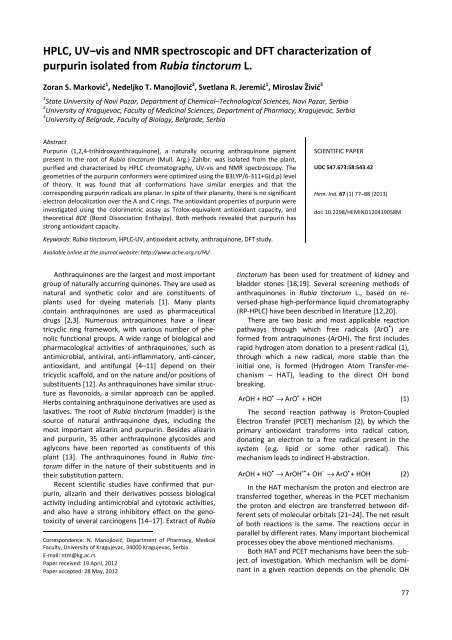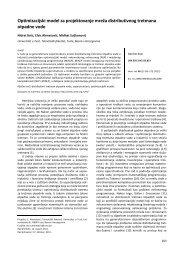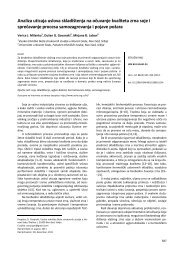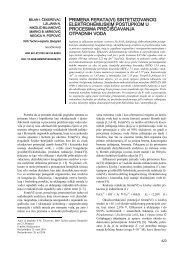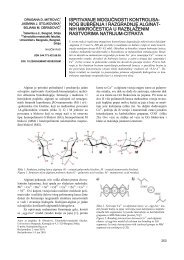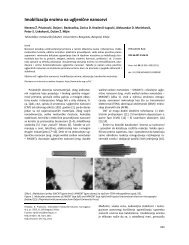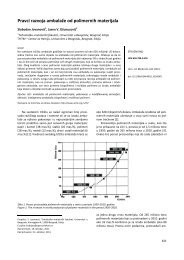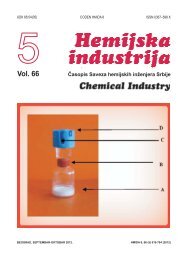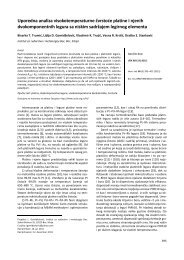HPLC, UV–vis and NMR spectroscopic and DFT ... - doiSerbia
HPLC, UV–vis and NMR spectroscopic and DFT ... - doiSerbia
HPLC, UV–vis and NMR spectroscopic and DFT ... - doiSerbia
Create successful ePaper yourself
Turn your PDF publications into a flip-book with our unique Google optimized e-Paper software.
<strong>HPLC</strong>, <strong>UV–vis</strong> <strong>and</strong> <strong>NMR</strong> <strong>spectroscopic</strong> <strong>and</strong> <strong>DFT</strong> characterization of<br />
purpurin isolated from Rubia tinctorum L.<br />
Zoran S. Marković 1 , Nedeljko T. Manojlović 2 , Svetlana R. Jeremić 1 , Miroslav Živić 3<br />
1 State University of Novi Pazar, Department of Chemical–Technological Sciences, Novi Pazar, Serbia<br />
2 University of Kragujevac, Faculty of Medicinal Sciences, Department of Pharmacy, Kragujevac, Serbia<br />
3 University of Belgrade, Faculty of Biology, Belgrade, Serbia<br />
Abstract<br />
Purpurin (1,2,4-trihidroxyanthraquinone), a naturally occuring anthraquinone pigment<br />
present in the root of Rubia tinctorum (Mull. Arg.) Zahlbr. was isolated from the plant,<br />
purified <strong>and</strong> characterized by <strong>HPLC</strong> chromatography, UV-vis <strong>and</strong> <strong>NMR</strong> spectroscopy. The<br />
geometries of the purpurin conformers were optimized using the B3LYP/6-311+G(d,p) level<br />
of theory. It was found that all conformations have similar energies <strong>and</strong> that the<br />
corresponding purpurin radicals are planar. In spite of their planarity, there is no significant<br />
electron delocalization over the A <strong>and</strong> C rings. The antioxidant properties of purpurin were<br />
investigated using the colorimetric assay as Trolox-equivalent antioxidant capacity, <strong>and</strong><br />
theoretical BDE (Bond Dissociation Enthalpy). Both methods revealed that purpurin has<br />
strong antioxidant capacity.<br />
Keywords: Rubia tinctorum, <strong>HPLC</strong>-UV, antioxidant activity, anthraquinone, <strong>DFT</strong> study.<br />
Available online at the Journal website: http://www.ache.org.rs/HI/<br />
Anthraquinones are the largest <strong>and</strong> most important<br />
group of naturally accurring quinones. They are used as<br />
natural <strong>and</strong> synthetic color <strong>and</strong> are constituents of<br />
plants used for dyeing materials [1]. Many plants<br />
contain anthraquinones are used as pharmaceutical<br />
drugs [2,3]. Numerous antraquinones have a linear<br />
tricyclic ring framework, with various number of phenolic<br />
functional groups. A wide range of biological <strong>and</strong><br />
pharmacological activities of anthraquinones, such as<br />
antimicrobial, antiviral, anti-inflammatory, anti-cancer,<br />
antioxidant, <strong>and</strong> antifungal [4–11] depend on their<br />
tricyclic scaffold, <strong>and</strong> on the nature <strong>and</strong>/or positions of<br />
substituents [12]. As anthraquinones have similar structure<br />
as flavonoids, a similar approach can be applied.<br />
Herbs containing anthraquinone derivatives are used as<br />
laxatives. The root of Rubia tinctorum (madder) is the<br />
source of natural anthraquinone dyes, including the<br />
most important alizarin <strong>and</strong> purpurin. Besides alizarin<br />
<strong>and</strong> purpurin, 35 other anthraquinone glycosides <strong>and</strong><br />
aglycons have been reported as constituents of this<br />
plant [13]. The anthraquinones found in Rubia tinctorum<br />
differ in the nature of their substituents <strong>and</strong> in<br />
their substitution pattern.<br />
Recent scientific studies have confirmed that purpurin,<br />
alizarin <strong>and</strong> their derivatives possess biological<br />
activity including antimicrobial <strong>and</strong> cytotoxic activities,<br />
<strong>and</strong> also have a strong inhibitory effect on the genotoxicity<br />
of several carcinogens [14–17]. Extract of Rubia<br />
Correspondence: N. Manojlović, Department of Pharmacy, Medical<br />
Faculty, University of Kragujevac, 34000 Kragujevac, Serbia.<br />
E-mail: ntm@kg.ac.rs<br />
Paper received: 19 April, 2012<br />
Paper accepted: 28 May, 2012<br />
SCIENTIFIC PAPER<br />
UDC 547.673:58:543.42<br />
Hem. Ind. 67 (1) 77–88 (2013)<br />
doi: 10.2298/HEMIND120419058M<br />
tinctorum has been used for treatment of kidney <strong>and</strong><br />
bladder stones [18,19]. Several screening methods of<br />
anthraquinones in Rubia tinctorum L., based on reversed-phase<br />
high-performance liquid chromatography<br />
(RP-<strong>HPLC</strong>) have been described in literature [12,20].<br />
There are two basic <strong>and</strong> most applicable reaction<br />
pathways through which free radicals (ArO • ) are<br />
formed from antraquinones (ArOH). The first includes<br />
rapid hydrogen atom donation to a present radical (1),<br />
through which a new radical, more stable than the<br />
initial one, is formed (Hydrogen Atom Transfer-mechanism<br />
– HAT), leading to the direct OH bond<br />
breaking.<br />
• •<br />
ArOH + HO → ArO + HOH<br />
(1)<br />
The second reaction pathway is Proton-Coupled<br />
Electron Transfer (PCET) mechanism (2), by which the<br />
primary antioxidant transforms into radical cation,<br />
donating an electron to a free radical present in the<br />
system (e.g. lipid or some other radical). This<br />
mechanism leads to indirect H-abstraction.<br />
• +• −<br />
•<br />
ArOH + HO ArOH + OH ArO + HOH<br />
→ → (2)<br />
In the HAT mechanism the proton <strong>and</strong> electron are<br />
transferred together, whereas in the PCET mechanism<br />
the proton <strong>and</strong> electron are transferred between different<br />
sets of molecular orbitals [21–24]. The net result<br />
of both reactions is the same. The reactions occur in<br />
parallel by different rates. Many important biochemical<br />
processes obey the above mentioned mechanisms.<br />
Both HAT <strong>and</strong> PCET mechanisms have been the subject<br />
of investigation. Which mechanism will be dominant<br />
in a given reaction depends on the phenolic OH<br />
77
Z.S. MARKOVIĆ et al.: CHARACTERIZATION OF PURPURIN ISOLATED FROM R.tinctorum Hem. ind. 67 (1) 77–88 (2013)<br />
bond strengths. The OH bond strength can be expressed<br />
as the OH bond dissociation enthalpy (BDE). This<br />
molecular property can be used in the assessment of<br />
possible radical scavenging potential of the molecule.<br />
BDE is calculated as the difference between the molecule<br />
(purpurin in this case) <strong>and</strong> its radical enthalpies.<br />
Density functional theory (<strong>DFT</strong>) often produces reliable<br />
results on the BDE with relatively reasonable computational<br />
cost [25–36]. It is worth pointing out that the<br />
small BDE value means that the OH bond is weak, <strong>and</strong><br />
that the reaction will probably obey the fast HAT mechanism.<br />
On the other h<strong>and</strong>, in the PCET mechanism,<br />
the ionization potential of ArOH plays an important<br />
role, because the rate of formation of ArOH +• determines<br />
the rate of the overall reaction. Whichever mechanism<br />
is operative, removing a hydrogen atom from<br />
ArOH needs to be easier than that from HOH. This<br />
means that both reactions (1) <strong>and</strong> (2) should be thermodynamically<br />
favorable, <strong>and</strong> that the formed radical<br />
species ArO • needs to be relatively stable. In this way,<br />
the antioxidant molecule prevents or postpones toxic<br />
effects of radicals (such as the oxidative stress), slowly<br />
reacting with the substrate <strong>and</strong> faster with the present<br />
radicals. In these reactions, neither the antioxidant molecule<br />
nor the final product obtained from it have toxic<br />
or pro-oxidant effects [37].<br />
The first part of this work is devoted to <strong>HPLC</strong> characterization<br />
of Rubia tinctorum L. specimens collected<br />
in central Serbia, isolation of major pigment, purpurin,<br />
<strong>and</strong> its characterization by <strong>UV–vis</strong> <strong>and</strong> <strong>NMR</strong> spectrescopy,<br />
<strong>and</strong> determination of its antioxidant capacity. In<br />
addition, a <strong>DFT</strong> study on the reactivity of the OH groups<br />
in purpurin <strong>and</strong> the structural <strong>and</strong> electronic features<br />
of the purpurin radicals were performed. The results<br />
for BDE, HOMO, <strong>and</strong> spin density of purpurin are presented.<br />
Structure-activity relationships are examined in<br />
the light of these results. Particular attention is devoted<br />
to the <strong>DFT</strong> interpretation of the reactivity of the<br />
OH groups in purpurin <strong>and</strong> the radicals formed after H<br />
removal from this molecule. Keto-enol tautomerism<br />
before H-abstraction is also discussed to explain the<br />
role of the OH groups.<br />
EXPERIMENTAL<br />
Chemical reagents<br />
All reagents used in the experiment were analytical<br />
grade in the highest purity available. Acetonitrile was of<br />
<strong>HPLC</strong> grade, <strong>and</strong> was purchased from Merck (Darmstadt,<br />
Germany). Deionized water used throughout the<br />
experiments was generated by a Milli-Q academic<br />
water purification system (Milford, MA, USA).<br />
Plant material<br />
Plant material was collected from Central Serbia (10<br />
km south of the Aranđelovac town) during July, 2008.<br />
78<br />
The studied plant was identified by Prof. Dr. Vasiljević,<br />
Department of Biology, Faculty of Science, University of<br />
Niš, Serbia, as Rubia tinctorum (L.) (voucher specimen<br />
UNI-2403).<br />
Preparation of plant extract <strong>and</strong> isolation of purpurin<br />
The plant material was air dried at room temperature<br />
(26 °C) for one week, after which it was grinded to<br />
a uniform powder. After extraction with methanol the<br />
residue was hydrolysis with 2 mol/L HCl, neutralized<br />
with solution NaOH <strong>and</strong> extracted with methanol. After<br />
evaporation of the solvent, the residue was partitioned<br />
between chloroform <strong>and</strong> water. The chloroform fraction<br />
was extracted with 1 mol/L NaOH, which was then<br />
acidified with HCl <strong>and</strong> extracted with chloroform. This<br />
extract was chromatographed on Sephadex LH-20<br />
(eluent chloroform-methanol 20:1, 10:1, 5:1 <strong>and</strong> 1:1) to<br />
yield purpurin which was identified according to spectral<br />
data [38]. Purpurin is a crystalline solid that forms<br />
red needles melting at 260 °C.<br />
High-performance liquid chromatography (<strong>HPLC</strong>)<br />
analysis<br />
High-performance liquid chromatography (<strong>HPLC</strong>)<br />
analysis was carried out on an Agilent 1200 Series <strong>HPLC</strong><br />
instrument with C18 column (C18; 25 cm×4.6 mm, 10<br />
m) <strong>and</strong> <strong>UV–vis</strong> spectrophotometric detector with two<br />
solvents, water <strong>and</strong> acetonitrile, in a linear gradient<br />
program (Table 1). The sample injection volume was 10<br />
μl. The flow rate of the mobile phase was kept constant<br />
at 1.0 mL min –1 <strong>and</strong> the chromatogram was recorded at<br />
250 nm while the UV spectra were monitored over a<br />
range of 600 to 200 nm. Purpurin was identified by<br />
comparison of its retention time <strong>and</strong> absorption spectrum<br />
to this of st<strong>and</strong>ard solution of purpurin.<br />
Table 1. Gradient table for <strong>HPLC</strong> analysis<br />
Time, min Water, % Acetonitrile, %<br />
0 70 30<br />
5 75 25<br />
20 40 60<br />
30 30 70<br />
40 75 25<br />
45 70 30<br />
<strong>NMR</strong> Spectra<br />
The 1 H- <strong>and</strong> 13 C-<strong>NMR</strong> spectra of purpurin were recorded<br />
at room temperature on a Bruker <strong>NMR</strong> spectrometer<br />
(500 MHz for 1 H- <strong>and</strong> 125 MHz for 13 C-<strong>NMR</strong>).<br />
TMS was used as internal st<strong>and</strong>ard. The samples were<br />
prepared by the dissolution of purpurin in DMSO (signal<br />
for 1 H- at 2.5 ppm <strong>and</strong> at 39.5 ppm for 13 C-<strong>NMR</strong>).
Z.S. MARKOVIĆ et al.: CHARACTERIZATION OF PURPURIN ISOLATED FROM R.tinctorum Hem. ind. 67 (1) 77–88 (2013)<br />
Antioxidant activity<br />
The 2,2’-azinobis-(3-ethylbenzothiazoline-6-sulphonic<br />
acid) (ABTS) <strong>and</strong> 6-hydroxy-2,5,7,8-tetramethylchroman-2-carboxylic<br />
acid (Trolox) were obtained from<br />
Fluka (Switzerl<strong>and</strong>). The total antioxidant activity of<br />
purpurin was determined by the colorimetric assay as<br />
Trolox-equivalent antioxidant capacity (TEAC). The<br />
stable ABTS radical monocation (ABTS +• ) was generated<br />
by the incubation of 7 mM ABTS with 2.5 mM potassium<br />
persulfate in the dark at room temperature for 16<br />
h before use. The ABTS +• solution was diluted immediately<br />
prior to assay to an absorbance of 0.70±0.02 at<br />
734 nm. 500 μL of diluted ABTS +• solution was placed in<br />
the quartz cuvette to record the initial absorbance.<br />
Then, various concentrations of purpurin or Trolox<br />
were added to each cuvette, mixed by inversion, <strong>and</strong><br />
the absorbance was read exactly at 60 s after addition.<br />
Parallel blanks were performed in each assay with the<br />
appropriate solvent alone. The percentage inhibition<br />
compared to initial absorbance after 60 s was plotted<br />
as a function of sample or Trolox concentration. TEAC<br />
value was expressed as the ratio of sample <strong>and</strong> Trolox<br />
slope (asample/aTrolox). Each assay was carried out in triplicate.<br />
Computational method<br />
All calculations were performed in vacuum, using<br />
Gaussian09 software package [39], at the B3LYP/6-<br />
-311+G(d,p) level of theory [40]. Six different in-plane<br />
conformations of purpurin were found <strong>and</strong> investtigated.<br />
The differences between conformations are in<br />
OH groups orientation at C1, C2, <strong>and</strong> C4 atoms. Obtained<br />
geometries were verified to be minima on the<br />
potential energy surface by a normal mode analysis –<br />
no imaginary frequencies were found. Transitions to<br />
the lowest excited singlet electronic states of purpurin<br />
were computed by using the TD-B3LYP procedure [40–<br />
–42]. The influence of methyl alcohol as solvent upon<br />
the electronic transitions was approximated by the<br />
polarized continuum model PCM [43,44]. <strong>UV–vis</strong> spec-<br />
tral analysis was performed using ChemCraft 1.5 [46],<br />
<strong>and</strong> Gaussum [45]. The calculation of <strong>NMR</strong> spectrum of<br />
purpurin was performed using the GIAO (Gauge-Including<br />
Atomic Orbitals) method [47,48], implemented<br />
in the Gaussian package. In order to express the chemical<br />
shifts in ppm, the geometry of the tetramethylsilane<br />
(TMS) molecule was optimized, <strong>and</strong> then its <strong>NMR</strong><br />
spectrum was calculated by using the same method<br />
<strong>and</strong> basis set as for the calculation of purpurin molecule.<br />
The obtained zero point energies were used to correct<br />
all energetic terms using the recommended scaling<br />
factor of 0.9887 [49]. Natural bond orbital (NBO) analysis<br />
[50] was performed for all structures. Bond dissociation<br />
enthalpy (BDE) for purpurin (Table 2) was calculated<br />
using the following equation:<br />
BDE = H −H− H<br />
POH • •<br />
PO H<br />
where H POH , H • , <strong>and</strong> H • present the enthalpy of<br />
PO<br />
H<br />
purpurin, purpurin radical, <strong>and</strong> hydrogen atom, respectively.<br />
The ionization potential (IP) was obtained as the<br />
energy difference between the POH <strong>and</strong> POH +• species.<br />
RESULTS AND DISCUSSIONS<br />
The <strong>HPLC</strong> chromatogram of the crude extract of<br />
Rubia tinctorum is shown in Figure 1. The tR values for<br />
purpurin is 25.24 min. Beside purpurin, very important<br />
anthraquinone alizarin was also identified (tR = 23.64<br />
min). The identification of these compounds were performed<br />
by comparison of their tR values with the st<strong>and</strong>ard<br />
substances. The <strong>UV–vis</strong> absorbance spectral results<br />
also correspond to the literature data [51]. Bearing<br />
in mind the importance of the pigment purpurin,<br />
this anthraquinone was isolated from the extract by<br />
column chromatography on silica gel. Purpurin contains<br />
three hydroxyl groups located in the same ring. These<br />
groups can play an important role in the expression of<br />
antioxidant activity of purpurin.<br />
Table 2. Calculated energies of the purpurin rotamers (1 to 6), purpurin radicals (1-OH, 2-OH, <strong>and</strong> 4-OH, <strong>and</strong> keto forms of purpurin<br />
Compound Total energy, a.u. Enthalpy, a.u. Free energy, a.u. BDE, kJ/mol<br />
1 –914.5376 –914.5269 –914.5802 –<br />
2 –914.5303 –914.5185 –914.5721 –<br />
3 –914.5160 –914.5037 –914.5587 –<br />
4 –914.5169 –914.5047 –914.5593 –<br />
5 –914.5072 –914.4947 –914.5501 –<br />
6 –914.4937 –914.4806 –914.5389 –<br />
1-OH –913.9010 –914.8891 –913.9441 362.15<br />
2-OH –913.8997 –913.8879 –913.9421 365.28<br />
4-OH –913.8862 –913.8741 –913.9294 401.58<br />
Keto C-2 –914.4638 –914.4514 –914.5072 163.80<br />
Keto C-11 –914.4940 –914.4822 –914.5363 244.68<br />
79
Z.S. MARKOVIĆ et al.: CHARACTERIZATION OF PURPURIN ISOLATED FROM R.tinctorum Hem. ind. 67 (1) 77–88 (2013)<br />
Figure 1. <strong>HPLC</strong> Chromatogram of the Rubia tinctorum specimen.<br />
To find the most stable conformation of purpurin,<br />
which will be used for further investigations, the conformational<br />
space of purpurin was explored as a function<br />
of the torsion angles τ1 (C2-C1-O1-H), τ2 (C3-C2-<br />
-O2-H) <strong>and</strong> τ3 (C3-C4-O4-H). In this way, the preferred<br />
relative positions among OH groups in relation to benzene<br />
ring were determined. The minimization procedure<br />
yielded a planar conformation (τ1 = τ2 = τ3 = 180°)<br />
Figure 2. The optimized geometries of the six conformations for purpurin.<br />
80<br />
as the most stable structure (1 in Figure 2). By removing<br />
constraint for the torsion angles, the conformational<br />
absolute minimum was found at (τ1 = τ2 = τ3 =<br />
= 180°. Five local minima were also found, i.e., conformations<br />
2–6, which are less stable than 1 by 22.1,<br />
60.9, 58.3, 84.5, <strong>and</strong> 121.5 kJ/mol, respectively (Table 2<br />
<strong>and</strong> Figure 2). Figure 2 shows that there is no deviation<br />
from planarity in any conformation of purpurin.
Z.S. MARKOVIĆ et al.: CHARACTERIZATION OF PURPURIN ISOLATED FROM R.tinctorum Hem. ind. 67 (1) 77–88 (2013)<br />
Bond lengths of the absolute minimum 1 calculated<br />
in vacuum <strong>and</strong> methanol as solvent are presented in<br />
Table 3. Table 3 shows that there are no significant<br />
differences between the geometries optimized in vacuum<br />
<strong>and</strong> methanol. In addition, it is evident that the<br />
majority of bonds in rings are longer than double bond,<br />
<strong>and</strong> shorter than single bond. The double bonds around<br />
the carbonyl groups in the ring C indicate a cross-conjugated<br />
system in which the delocalization is allowed<br />
only between A <strong>and</strong> C, or B <strong>and</strong> C, but not between A<br />
<strong>and</strong> B rings. The results of NBO analysis of 1 reveal two<br />
strong double bonds in C9-O <strong>and</strong> C10-O carbonyl groups,<br />
which form hydrogen bonds with the hydrogens of the<br />
adjacent hydroxyl groups. These hydrogen bonds have<br />
a significant stabilizing effect, as in emodin [52] <strong>and</strong><br />
lichexanthone [53]. Structure 6, which lacks these hydrogen<br />
bonds, is the most unstable conformation of<br />
purpurin (Table 2).<br />
To verify the geometry obtained by the <strong>DFT</strong> method,<br />
detailed analysis of the experimental <strong>and</strong> theoretical<br />
<strong>UV–vis</strong> <strong>and</strong> <strong>NMR</strong> spectra was performed. Both<br />
experimental <strong>and</strong> theoretical UV-vis spectra are presented<br />
in Figure 3, whereas calculated electronic transitions<br />
are given in Table 4. There is generally a very satisfactory<br />
agreement between the observed <strong>and</strong> predicted<br />
wave numbers <strong>and</strong> intensities.<br />
The maximum for b<strong>and</strong> A, whose calculated value is<br />
467 nm, corresponds to the experimental value of 482<br />
Table 3. Bond lengths of purpurin (1) <strong>and</strong> its radicals (1-OH, 2-OH <strong>and</strong> 3-OH) calculated using B3LYP/6-311+G(d,p) level of theory<br />
7<br />
6<br />
8 9<br />
14<br />
5<br />
13<br />
10<br />
O<br />
O<br />
H<br />
11<br />
H<br />
O<br />
A C B<br />
Species bond<br />
1 1 (methanol)<br />
Length, nm<br />
1-OH 2-OH 4-OH<br />
C1–C2 0.1427 0.1424 0.1489 0.1499 0.1435<br />
C2–C3 0.1377 0.1377 0.1366 0.1437 0.1359<br />
C3–C4 0.1408 0.1406 0.1407 0.1376 0.1459<br />
C4–C12 0.1411 0.1410 0.1442 0.1445 0.1478<br />
C10–C12 0.1451 0.1450 0.1469 0.1464 0.1483<br />
C10–C13 0.1488 0.1484 0.1473 0.1482 0.1502<br />
C5–C13 0.1398 0.1398 0.1401 0.1399 0.1397<br />
C5–C6 0.1390 0.1391 0.1388 0.1390 0.1390<br />
C6–C7 0.1398 0.1397 0.1399 0.1398 0.1399<br />
C7–C8 0.1389 0.1390 0.1390 0.1389 0.1388<br />
C8–C14 0.1399 0.1399 0.1397 0.1399 0.1401<br />
C13–C14 0.1408 0.1410 0.1404 0.1407 0.1405<br />
C9–C14 0.1480 0.1478 0.1497 0.1477 0.1469<br />
C9–C11 0.1464 0.1464 0.1488 0.1465 0.1475<br />
C11–C12 0.1428 0.1428 0.1405 0.1422 0.1406<br />
C1–C11 0.1392 0.1392 0.1453 0.1406 0.1415<br />
C1–O1 0.1346 0.1344 0.1239 0.1305 0.1326<br />
C2–O2 0.1348 0.1348 0.1323 0.1232 0.1351<br />
C4–O3 0.1336 0.1341 0.1318 0.1338 0.1237<br />
C9–O4 0.1243 0.1245 0.1219 0.1243 0.1245<br />
C10–O5 0.1245 0.1249 0.1246 0.1242 0.1219<br />
DH(O4⋅⋅⋅H–O1) 0.1675 0.1674 – 0.1615 0.1575<br />
DH(O1⋅⋅⋅H–O2) 0.2116 0.2138 0.194563 – 0.2124<br />
DH(O5⋅⋅⋅H–O3) 0.1679 0.1662 0.157677 0.1683 –<br />
12<br />
O<br />
1<br />
4<br />
H<br />
2<br />
3<br />
O<br />
81
Z.S. MARKOVIĆ et al.: CHARACTERIZATION OF PURPURIN ISOLATED FROM R.tinctorum Hem. ind. 67 (1) 77–88 (2013)<br />
Figure 3. Experimental (top) <strong>and</strong> calculated (bottom) UV spectra for purpurin.<br />
nm. This is essentially a HOMO–LUMO transition, involving<br />
excitation from π to π*. The shapes of the<br />
orbitals are shown in Figure 4. They indicate that the<br />
transition is associated with significant charge-transfer<br />
form the ring B to the ring A, similar to the situation<br />
characterizing the color b<strong>and</strong>s in related compounds,<br />
such as chrysazin <strong>and</strong> anthralin, <strong>and</strong> the first strong<br />
<strong>UV–vis</strong> b<strong>and</strong> of the parent anthraquinone chromophore<br />
[54].<br />
82<br />
Similar charge transfer from the ring A to the ring B<br />
is observed for peak B, whose theoretical maximum is<br />
predicted at 305 nm. This b<strong>and</strong> is in good agreement<br />
with the experimental polarization value of 291 nm.<br />
This transition involves excitation from HOMO-4 to<br />
LUMO. The experimental value for peak C at 252 nm is<br />
in excellent agreement with the calculated electronic<br />
transition of 254 nm. This peak mainly represents excitation<br />
from HOMO-1 to LUMO+1.
Z.S. MARKOVIĆ et al.: CHARACTERIZATION OF PURPURIN ISOLATED FROM R.tinctorum Hem. ind. 67 (1) 77–88 (2013)<br />
Table 4. Experimental <strong>and</strong> calculated electronic transitions for<br />
purpurin; λ – wave numbers in nm, f – oscillator strength<br />
Case<br />
Experimental TD- B3LYP/6-311+G(d,p)<br />
λ Λ f Leading configurations<br />
A 482 466.9 0.2028 H→L(98%)<br />
B 291 305.3 0.1675 H-4→L(81%)<br />
C 252 254.2 0.6015 H-1→L+1(69%)<br />
H→L+2(17%)<br />
Figure 4. Selected molecular orbitals for purpurin.<br />
The experimental <strong>and</strong> calculated 1 H- <strong>and</strong> 13 C-<strong>NMR</strong><br />
spectra of purpurin are presented in Table 5.<br />
Obviously, there is a very good agreement between<br />
the experimental <strong>and</strong> theoretical values for the chemical<br />
shifts of the proton spectrum. Scaled theoretical<br />
values (scaling factor 0.953) for 13 C chemical shifts are<br />
also in accord with the experimental data. The agreement<br />
between the experimental <strong>and</strong> theoretical results<br />
indicates that the structure of purpurin used for the<br />
<strong>UV–vis</strong> <strong>and</strong> <strong>NMR</strong> measurements corresponds to that of<br />
1 (Figure 2).<br />
It is well known that some anthraquinones are very<br />
good antioxidants. The structure of purpurin indicates a<br />
possibility of conjugation <strong>and</strong> antioxidant properties.<br />
This assumption is based on the suggestion of van<br />
Acker et al. [55] <strong>and</strong> Rice-Evans et al. [56], who supposed<br />
that the antioxidant properties of flavonoids<br />
could be derived just from their good delocalization<br />
possibilities. The same consideration can be applied to<br />
anthraquinones. Bearing this in mind, purpurin was<br />
screened for its antioxidant potential using the relative<br />
ability to scavenge the ABTS +• radical cation generated<br />
in the aqueous phase, expressed as the Trolox equivalent<br />
antioxidant capacity (TEAC). Purpurin was found<br />
Table 5. Experimental <strong>and</strong> theoretical chemical shifts (in ppm)<br />
for purpurin molecule<br />
Atom Exp. Calcd. Atom Exp. Calcd.<br />
C1 157.1 152.8 C12 109.7 111.3<br />
C2 149.3 152.3 C13 133.3 141.6<br />
C3 126.6 116.1 C14 134.5 138.9<br />
C4 160.3 169.2 H1 13.2 13.5<br />
C5 126.2 133.3 H2 11.6 11.3<br />
C6 134.1 140.8 H3 6.5 6.4<br />
C7 134.9 139.1 H4 12.9 13.4<br />
C8 126.5 133.1 H5 8.0 8.6<br />
C9 183.3 194.5 H6 7.8 7.5<br />
C10 186.6 190.0 H8 7.8 7.9<br />
C11 112.4 118.4 H8 8.1 8.7<br />
83
Z.S. MARKOVIĆ et al.: CHARACTERIZATION OF PURPURIN ISOLATED FROM R.tinctorum Hem. ind. 67 (1) 77–88 (2013)<br />
to have the TEAC value of 1.950±0.008 mM. This result<br />
is in agreement with that reported [57], <strong>and</strong> indicates<br />
that purpurin has a good antioxidant activity.<br />
There is no detailed description of the radical cation<br />
of purpurin in literature. The radical cation formed by<br />
removing an electron from 1, Figure 2, is planar, <strong>and</strong><br />
hydrogen bonds are retained as in the parent molecule,<br />
contributing to further stabilization. The obtained value<br />
for the ionization potential (744.2 kJ/mol) of 1 is higher<br />
than the corresponding values for flavonoids [25], but<br />
is lower than the corresponding values for emodin <strong>and</strong><br />
lichexanthone [52,53]. On the basis of the ionization<br />
potential value, stronger antioxidant activity of purpurin<br />
than that for emodin <strong>and</strong> lichexanthone can be<br />
expected.<br />
It is well known that there is good correlation<br />
between antioxidant activity <strong>and</strong> BDE values [25,52].<br />
For this reason, the values of BDE for the OH groups of<br />
purpurin were determined. The obtained results (Table<br />
2) show that 1-OH <strong>and</strong> 2-OH groups are responsible for<br />
the antioxidant activity of purpurin. The BDE value for<br />
homolytic cleavage of the 1-OH bond is higher than<br />
those for dissociation of the OH groups in fisetin [58],<br />
<strong>and</strong> particularly in quercetin [25,26]. On the other h<strong>and</strong>,<br />
the obtained value is lower than the corresponding value<br />
for emodin [52].<br />
In the text below, some properties of the radicals,<br />
formed by homolytic cleavage of the OH groups of purpurin<br />
will be discussed. Geometry optimization of the<br />
radicals was performed by starting from the optimized<br />
structure of the parent molecule 1, <strong>and</strong> removing a<br />
hydrogen atom from the OH groups at positions 1, 2<br />
<strong>and</strong> 4. In the further discussion, the radical formed by<br />
H-removal from the x-OH group of purpurin is called<br />
the x-OH radical (x = 1, 2, or 4), for example 2-OH radical.<br />
Since the BDE value for 4-OH radical is significantly<br />
higher than that of 1-OH radical by almost 40<br />
kJ/mol, only 1-OH, <strong>and</strong> 2-OH radicals will be further<br />
considered.<br />
Inspection of the geometries of the obtained radicals<br />
shows that they retain planarity, like the parent<br />
molecule. Inspection of Table 3 allows further comment<br />
on the electronic structure of both radicals. In<br />
both radicals, complete delocalization involves only<br />
ring A, while ring B is characterized by three double<br />
bonds in 1-OH radical (C1-O, C2-C3, <strong>and</strong> C11-C12), <strong>and</strong><br />
by two double bonds in 2-OH radical (C2-O <strong>and</strong> C3-C4).<br />
On the basis of these structural features of the radicals,<br />
it is clear that delocalization between rings C <strong>and</strong> B is<br />
restricted. A consequence of the restricted delocalization<br />
is the decreased stability of both radicals, implying<br />
that their BDE values are slightly higher in comparison<br />
to those obtained for the majority of the flavones<br />
[25,26,57].<br />
84<br />
To underst<strong>and</strong> the relationship between the electron<br />
delocalization <strong>and</strong> the reactivity of a radical, the<br />
electron distribution in the singly occupied molecular<br />
orbital (SOMO) needs to be examined. The SOMO of<br />
the 1-OH radical (Figure 5) is mainly delocalized over<br />
carbonyl groups. As SOMO is the α-highest occupied<br />
molecular orbital, it does not describe the global electronic<br />
behavior of the radical, <strong>and</strong> its shape is not a<br />
reliable indicator for the reactivity of the purpurin radical.<br />
Figure 5. SOMO <strong>and</strong> spin density of the 1-OH radical.<br />
Spin density is often considered to be a more realistic<br />
parameter, <strong>and</strong> provides a more reliable representation<br />
of the reactivity [54]. The importance of spin<br />
density for the description of flavonoids has been<br />
pointed out in the papers of Leopoldini et al. [25,26],<br />
<strong>and</strong> Marković et al. [36,52,53]. The lower the BDE value,<br />
the more delocalized spin density in the radical,<br />
<strong>and</strong> easier radical formation are. As this consideration<br />
can be applied to antraquinones, the spin density in the<br />
purpurin radical was analyzed. The spin density distribution<br />
in the 1-OH radical indicates the oxygen atom<br />
bonded to C1 as the most probable radical center, followed<br />
by the adjacent carbons C2 <strong>and</strong> C11, <strong>and</strong> nonadjacent<br />
carbons C4 <strong>and</strong> C12 (Figure 5). Weak delocalization<br />
of the spin density exists over the ring C.<br />
The OH groups of purpurin can also undergo ketoenol<br />
tautomerism. Hydrogen atom from 1-OH position<br />
can migrate to positions 2 or 11, thus yielding two tautomers<br />
(Scheme 1). The BDE values for the formation<br />
of the 1-OH radical by H-abstraction from the C2 <strong>and</strong>
Z.S. MARKOVIĆ et al.: CHARACTERIZATION OF PURPURIN ISOLATED FROM R.tinctorum Hem. ind. 67 (1) 77–88 (2013)<br />
Scheme 1. Keto-enol tautomerism in purpurin.<br />
C11 of the keto forms of 1 were calculated (Table 2),<br />
<strong>and</strong> the values of 163.80 <strong>and</strong> 244.68 kJ/mol were obtained.<br />
These low BDE values indicate the relatively<br />
high capacity of H-removal from the C11, <strong>and</strong> especially<br />
from the C2 site in the keto forms. However, it should<br />
be noted that the keto forms of purpurin are less stable<br />
than the enols form, the latter being stabilized by πconjugation<br />
in the B-ring. The differences in stability<br />
between 1, <strong>and</strong> C2 <strong>and</strong> C11 keto forms amount to<br />
198.35 <strong>and</strong> 117.47 kJ/mol in favor of purpurin. For instance,<br />
in the case of emodin <strong>and</strong> quercetin this difference<br />
in stability is only 61.5 <strong>and</strong> 83.8 kJ/mol [52],<br />
whereas for lichexanthone it amounts 271.9 kJ/mol<br />
[53]. These differences in stability between enol <strong>and</strong><br />
keto forms indicate that the contribution of keto forms<br />
can be considered negligible for purpurin as a free molecule.<br />
On the other h<strong>and</strong>, it can be presumed that, in<br />
some enzymatic processes, stability difference between<br />
two forms is reduced, so that keto forms become relevant,<br />
<strong>and</strong> then H-abstraction from the C2 or C11 positions<br />
can take place easily, thereby contributing to<br />
the antioxidant properties.<br />
CONCLUSIONS<br />
The <strong>HPLC</strong> characterization of the extract of Rubia<br />
tinctorum specimens collected in central Serbia was<br />
perfomed. The very important anthraquinone, purpurin,<br />
was isolated <strong>and</strong> identified using <strong>HPLC</strong>, <strong>UV–vis</strong> <strong>and</strong><br />
<strong>NMR</strong> spectral methods. The purpurin structure was determined<br />
by B3LYP/6-311+G (d,p) method. Comparison<br />
of the calculated <strong>UV–vis</strong> <strong>and</strong> 1 H- <strong>and</strong> 13 C-<strong>NMR</strong> spectra<br />
with the experimental data confirmed that structure 1,<br />
Figure 2, is likely structure of purpurin. Biological activity<br />
of anthraquinones is associated mainly with their<br />
tricyclic scaffold, but it may vary depending on the nature<br />
<strong>and</strong>/or position of substituents. On the basis of the<br />
obtained results, it is clear that purpurin, as well as its<br />
radicals, appears to be a planar tricyclic species. In spite<br />
of the planarity of the radical structure, there is no<br />
electronic delocalization between adjacent rings. It is<br />
supposed that this is one of the main reasons for higher<br />
values of BDE in comparison to those for flavones. In<br />
addition, the increased BDE values can be attributed to<br />
the cleavage of the strong hydrogen bonds, involved in<br />
the process of H-removal. Theoretical results are in accord<br />
with the experimental TEAC value. It was found<br />
that enol form is the most stable tautomer of the free<br />
molecule. Keto forms, which possess some lower BDE<br />
values for H-abstraction on the C2 or C11 atoms, might<br />
play a significant role in real systems, depending on the<br />
molecular environment of purpurin <strong>and</strong> on oxidative<br />
system acting on the molecule.<br />
Acknowledgements<br />
The authors acknowledge financial support by the<br />
Ministry of Education, Science <strong>and</strong> Technological Development<br />
of the Republic of Serbia (Grants No.<br />
172015 <strong>and</strong> 174028).<br />
REFERENCES<br />
[1] R.A. Muzychkina, Natural Anthraquinones, Biological<br />
<strong>and</strong> Physicochemical Properties, House Phasis, Moscow,<br />
1998.<br />
85
Z.S. MARKOVIĆ et al.: CHARACTERIZATION OF PURPURIN ISOLATED FROM R.tinctorum Hem. ind. 67 (1) 77–88 (2013)<br />
[2] B. Li, D. M. Zhang, Y. M. Luo, X.G. Chen, Three new <strong>and</strong><br />
antitumor anthraquinone glycosides from Lasianthus<br />
acuminatissimus MERR, Chem. Pharm. Bull. 54 (2006)<br />
297–300.<br />
[3] Y. Duan, J. Yu, S. Liu, M. Ji, Synthesis of anthraquinoneibuprofen<br />
prodrugs with hydroxyapatite affinity <strong>and</strong><br />
anti-inflammatory activity characteristics, Med. Chem. 5<br />
(2009) 577–582.<br />
[4] Y. Akao, Y. Nakagawa, M. Iinuma, Y. Nozawa, Anti-cancer<br />
effects of xanthones from pericarps of mangosteen,<br />
Int. J. Mol. Sci. 9 (2008) 355–370.<br />
[5] L.G. Chen, L.L. Yang, C.C. Wang, Anti-inflammatory activity<br />
of mangostins from Garcinia mangostana, Food<br />
Chem. Toxicol. 46 (2008) 688–693.<br />
[6] S. Suksamrarn, O. Komutiban, P. Ratananukul, N. Chimnoi,<br />
N. Lartpornmatulee, A. Suksamrarn, Cytotoxic prenylated<br />
xanthones from the young fruit of Garcinia<br />
mangostana, Chem. Pharm. Bull. 54 (2006) 301–305.<br />
[7] J. Pedraza-Chaverri, N. Cárdenas-Rodríguez, M. Orozco-<br />
Ibarra, J.M. Pérez-Rojas, Medicinal properties of mangosteen<br />
(Garcinia mangostana), Food Chem. Toxicol. 46<br />
(2008) 3227–3239.<br />
[8] G. Gopalakrishnan, B. Banumathi, G.J. Suresh, evaluation<br />
of the antifungal activity of natural xanthones from<br />
Garcinia mangostana <strong>and</strong> their synthetic derivatives,<br />
Nat. Prod. 60 (1997) 519–524.<br />
[9] T.N. Manojlovic, S. Solujic, S. Sukdolak, Antimicrobial<br />
activity of an extract <strong>and</strong> anthraquinones from Caloplaca<br />
schaereri, Lichenologist 34 (2002) 83–85.<br />
[10] J.C. Cyoug, T. Matsumoto, K. Arakawa, H. Kiyohara, H.<br />
Yamoda, Y. Otsuka, Anti-Bacteroides fragilis substance<br />
from Rhubarb, J. Ethnopharmacol. 19 (1987) 279–283.<br />
[11] G.C. Yen, P.D. Duh, D.Y. Chuang, Antioxidant activity of<br />
anthraquinones <strong>and</strong> anthrone, Food Chem. 70 (2000)<br />
437–441.<br />
[12] M.M.M. Pinto, M.E. Souza, M.S.J. Nascimento, Xanthone<br />
derivatives: New insights in biological activities, Curr.<br />
Medic. Chem. 12 (2005) 2517–2538.<br />
[13] G.C.H. Derksen, H.A.G. Niederländer, T.A. van Beek,<br />
Analysis of anthraquinones in Rubia tinctorum L. by liquid<br />
chromatography coupled with diode-array UV <strong>and</strong><br />
mass spectrometric detection, J. Chromatogr., A 978<br />
(2002) 119–127.<br />
[14] J.N. Hao, M.P. Huang, H. Lee, Structure-activity relationships<br />
of anthraquinones as inhibitors of 7-ethoxycoumarin<br />
O-deethylase <strong>and</strong> mutagenicity of 2-amino-3methylimidazo[4,5-f]quinoline,<br />
Mutat. Res. 328<br />
(1995) 183–191.<br />
[15] T.H. Marczylo, T. Hayatsu, S. Arimoto-Kobayashi, M.<br />
Tada, K. Fujita, T. Kamataki, K. Nakayama, H. Hayatsu,<br />
Protection against the bacterial mutagenicity of heterocyclic<br />
amines by purpurin, a natural anthraquinone pigment,<br />
Mutat. Res. 444 (1999) 451–461.<br />
[16] T.H. Marczylo, S. Arimoto-Kobayashi, H. Hayatsu, Protection<br />
against Trp-P-2 mutagenicity by purpurin: mechanism<br />
of in vitro antimutagenesis, Mutagenesis 15<br />
(2000) 223–228.<br />
86<br />
[17] N.T. Manojlović, S. Solujić, S. Sukdolak, M. Milošev, Antifungal<br />
activity of Rubia tinctorum, Rhamnus frangula<br />
<strong>and</strong> Caloplaca cerina, Fitoterapia 76 (2005) 244–246.<br />
[18] J. Westendorf, W. Pfau, A. Schulte, Carcinogenicity <strong>and</strong><br />
DNA adduct formation observed in ACI rats after longterm<br />
treatment with madder root, Rubia tinctorum L.,<br />
Carcinogenesis 19 (1998) 2163–2168.<br />
[19] B. Blömeke, B. Poginsky, C. Schmutte, H. Marquardt, J.<br />
Westendorf, Formation of genotoxic metabolites from<br />
anthraquinone glycosides, present in Rubia tinctorum L,<br />
Mutat. Res. 265 (1992) 263–272.<br />
[20] P. Bányai, I.N. Kuzovkina, L. Kursinszki, É. Szőke, <strong>HPLC</strong><br />
Analysis of Alizarin <strong>and</strong> Purpurin Produced by Rubia<br />
tinctorum L., Hairy Root Cultures 63 (2006) 111–114.<br />
[21] M.J. Mayer, Proton-coupled electron transfer: A Reaction<br />
Chemist's View, Annu. Rev. Phys. Chem. 55 (2004)<br />
363–390.<br />
[22] G.A. DiLabio, R.E. Johnson, Lone pair-π <strong>and</strong> π-π interactions<br />
play an important role in proton-coupled electron<br />
transfer reactions, J. Am. Chem. Soc. 129 (2007)<br />
6199–6203.<br />
[23] G.A. DiLabio, K.U. Ingold, A theoretical study of the<br />
iminoxyl/oxime self-exchange reaction. A five-center,<br />
cyclic proton-coupled electron transfer, J. Am. Chem.<br />
Soc. 127 (2005) 6693–6699.<br />
[24] M. Sjödin, S. Styring, B. Åkermark, L. Sun, L. Hammarström,<br />
Proton-coupled electron transfer from tyrosine<br />
in a tyrosine-ruthenium-tris-bipyridine complex: Comparison<br />
with tyrosinez oxidation in photosystem II, J. Am.<br />
Chem. Soc. 122 (2000) 3932–3936.<br />
[25] M. Leopoldini, I.P. Pitarch, N. Russo, M. Toscano, Structure,<br />
conformation, <strong>and</strong> electronic properties of apigenin,<br />
luteolin, <strong>and</strong> taxifolin antioxidants. A First principle<br />
theoretical study, J. Phys. Chem., A 108 (2004) 92–96.<br />
[26] M. Leopoldini, T. Marino, N. Russo, M. Toscano, Density<br />
functional computations of the energetic <strong>and</strong> <strong>spectroscopic</strong><br />
parameters of quercetin <strong>and</strong> its radicals in the gas<br />
phase <strong>and</strong> in solvent, Theor. Chem. Acc. 111 (2004)<br />
210–216.<br />
[27] M. Lucarini, F. G. Pedulli, M. Guerra, A critical evaluation<br />
of the factors determining the effect of intramolecular<br />
hydrogen bonding on the O-H bond dissociation enthalpy<br />
of catechol <strong>and</strong> of flavonoid antioxidants, Chem-<br />
Eur. J. 10 (2004) 933–939.<br />
[28] K. Lemaska, H. Szymusiak, B. Tyrakowska, R. Zieliski,<br />
A.E.M.F. Soffers, I.M.C.M. Rietjens, The influence of pH<br />
on antioxidant properties <strong>and</strong> the mechanism of<br />
antioxidant action of hydroxyflavones, Free Radical Bio.<br />
Med. 31 (2001) 869–881.<br />
[29] P. Trouillas, C. Fagnère, R. Lazzaroni, A.C. Calliste, A.<br />
Marfak, L.J. Duroux, A theoretical study of the conformational<br />
behavior <strong>and</strong> electronic structure of taxifolin<br />
correlated with the free radical-scavenging activity,<br />
Food Chem. 88 (2004) 571–582.<br />
[30] H.Y. Zhang, On the effectiveness of the EPR radical<br />
equilibration technique in estimating O–H bond dissociation<br />
enthalpies of catechols <strong>and</strong> other complex polyphenols,<br />
New J. Chem. 28 (2004) 1284–1285.
Z.S. MARKOVIĆ et al.: CHARACTERIZATION OF PURPURIN ISOLATED FROM R.tinctorum Hem. ind. 67 (1) 77–88 (2013)<br />
[31] H.Y. Zhang, Y.M. Sun, X.L. Wang, Substituent effects on<br />
O-H bond dissociation enthalpies <strong>and</strong> ionization potentials<br />
of catechols: A <strong>DFT</strong> study <strong>and</strong> its implications in the<br />
rational design of phenolic antioxidants <strong>and</strong> elucidation<br />
of structure–activity relationships for flavonoid antioxidants,<br />
Chem-Eur. J. 9 (2003) 502–508.<br />
[32] K.I. Priyadarsini, D.K. Maity, G.H. Naik, M.S. Kumar, M.K.<br />
Unnikrishnan, J.G. Satav, Role of phenolic O-H <strong>and</strong><br />
methylene hydrogen on the free radical reactions <strong>and</strong><br />
antioxidant activity of curcumin, Free Radical Bio. Med.<br />
35 (2003) 475–484.<br />
[33] N. Russo, M. Toscano, N. Uccella, Semiempirical molecular<br />
modeling into quercetin reactive site: Structural,<br />
conformational, <strong>and</strong> electronic features, J. Agric. Food<br />
Chem. 48 (2000) 3232–3237.<br />
[34] S.J. Wright, R.E. Jonhson, A.G. DiLabio, Predicting the<br />
activity of phenolic antioxidants: Theoretical method,<br />
analysis of substituent effects, <strong>and</strong> application to major<br />
families of antioxidants, J. Am. Chem. Soc. 123 (2001)<br />
1173–1183.<br />
[35] Y.H. Zhang, M.Y. Sun, Z.D. Chen, O–H bond dissociation<br />
energies of phenolic compounds are determined by<br />
field/inductive effect or resonance effect? A <strong>DFT</strong> study<br />
<strong>and</strong> its implication, QSAR 20 (2001) 148–152.<br />
[36] Z.S. Marković, J.M.D. Marković, Ć. Doličanin, A PM6<br />
study on the reactivity of OH groups in fisetin: Structural<br />
<strong>and</strong> electronic features of fisetins radicals, J. Ser. Soc.<br />
Comp. Mech. 3 (2009) 43–55.<br />
[37] P. Mulder, G.H. Korth, U.K. Ingold, Why quantum-thermochemical<br />
calculations must be used with caution to<br />
indicate a promising lead antioxidant, Helv. Chim. Acta<br />
88 (2005) 370-374.<br />
[38] R.H. Thomson, Natural Occurring Quinones, Academic<br />
Press, London, New York, 1971.<br />
[39] Gaussian 09, Revision A.1-SMP, Gaussian Inc., 2009,<br />
Wallingford, CT.<br />
[40] A. D. Becke, Density-functional thermochemistry. 2. The<br />
effect of the Perdew-Wang generalized-gradient<br />
correlation correction, J. Chem. Phys. 97 (1992) 9173–<br />
–9177.<br />
[41] A.D. Becke, Density-functional thermochemistry. 3. The<br />
role of exact exchange, J. Chem. Phys. 98 (1993) 5648–<br />
–5652.<br />
[42] C. Lee, W. Yang, R.G Parr, Development of the Colle-<br />
Salvetti correlation-energy formula into a functional of<br />
the electron density, Phys. Rev., B 37 (1988) 785–789.<br />
[43] S. Miertuš, S. Scrocco, J. Tomasi, Electrostatic interaction<br />
of a solute with a continuum. A direct utilizaion of<br />
AB initio molecular potentials for the prevision of<br />
solvent effects, Chem. Phys. 55 (1981) 117–129.<br />
[44] J. Tomasi, B. Mennucci, R. Cammi, Quantum mechanical<br />
continuum solvation models, Chem. Rev. 105 (2005)<br />
2999–3094.<br />
[45] N.M. O'boyle, A.L. Tenderholt, K.M. Langner, cclib: A<br />
library for package-independent computational chemistry<br />
algorithms, J. Comp. Chem. 29 (2008) 839–845.<br />
[46] G.A. Zhurko, D. A. Zhurko, Chemcraft 1.6, Chemcraft<br />
graphical program for working with quantum chemistry<br />
results, 2009. Available from: http://www.chemcraftprog.com<br />
(accessed on Feb, 2013).<br />
[47] R. Ditchfield, Self-consistent perturbation theory of diamagnetism,<br />
Mol. Phys. 27 (1974) 789–807.<br />
[48] K. Wolinski, J. Hilton, F.P. Pulay, Efficient implementation<br />
of the gauge-independent atomic orbital method<br />
for <strong>NMR</strong> chemical shift calculations, J. Am. Chem. Soc.<br />
112 (1990) 8251–8260.<br />
[49] J.P. Merrick, D. L. Moran, L. Radom, An evaluation of<br />
harmonic vibrational frequency scale factors, J. Phys.<br />
Chem. 111 (2007) 11683–11700.<br />
[50] J.P. Foster, F. Weinhold, Natural hybrid orbitals, J. Am.<br />
Chem. Soc. 102 (1980) 7211–7218.<br />
[51] C.H.G. Derksena, A.G.H. Niederl<strong>and</strong>erb, A.T. van Beek,<br />
Analysis of anthraquinones in Rubia tinctorum L. by liquid<br />
chromatography coupled with diode-array UV <strong>and</strong><br />
mass spectrometric detection, J. Chromatog., A 978<br />
(2002) 119–127.<br />
[52] S.Z. Marković, T.N. Manojlović, <strong>DFT</strong> study on the reactivity<br />
of OH groups in emodin: structural <strong>and</strong> electronic<br />
features of emodin radicals, Monatsh. Chem. 140 (2009)<br />
1311–1318.<br />
[53] S.Z. Marković, T.N. Manojlović, Analytical characterization<br />
of lichexanthone in lichen: <strong>HPLC</strong>, UV <strong>spectroscopic</strong>,<br />
<strong>and</strong> <strong>DFT</strong> analysis of lichexanthone extracted from<br />
Laurera benguelensis (Mull. Arg.) Zahlbr, Monatsh.<br />
Chem. 141 (2010) 945–952.<br />
[54] S. Møller, K.B. Andersen, J. Spanget-Larsen, J. Waluk,<br />
Excited-state intramolecular proton transfer in anthraxlin:<br />
Quantum chemical calculations <strong>and</strong> fluorescence<br />
spectra, Chem. Phys. Lett. 291 (1998) 51–56.<br />
[55] S.A.B.E. van Acker, M.J. Groot, W.J.F. van der Vijgh,<br />
M.N.J.L. Tromp, G.F. den Kelder, E.J.F. van der Vijgh, A.<br />
Bast, A Quantum chemical explanation of the antioxidant<br />
activity of flavonoids, Chem. Res. Toxicol. 9 (1996)<br />
1305–1312.<br />
[56] C.A. Rice-Evans, N.J. Miller, G. Paganga, Structure-antioxidant<br />
activity relationships of flavonoids <strong>and</strong> phenolic<br />
acids, Free Radic. Biol. Med. 20 (1996) 933–956.<br />
[57] Y.Z. Cai, M. Sun, J. Xing, Q. Luo, H. Corke, Structure–radical<br />
scavenging activity relationships of phenolic compounds<br />
from traditional Chinese medicinal plants, Life<br />
Sciences 78 (2006) 2872–2888.<br />
[58] S.Z. Marković, J.M. Dimitrić-Marković, Ć.B. Doličanin,<br />
Mechanistic pathways for the reaction of quercetin with<br />
hydroperoxy radical, Theor. Chem. Acc. 127 (2010) 69–<br />
–80.<br />
87
Z.S. MARKOVIĆ et al.: CHARACTERIZATION OF PURPURIN ISOLATED FROM R.tinctorum Hem. ind. 67 (1) 77–88 (2013)<br />
IZVOD<br />
<strong>HPLC</strong>, <strong>UV–vis</strong>, <strong>NMR</strong> spektroskopska i <strong>DFT</strong> karakterizacija purpurina izolovanog iz Rubia tinctorum L.<br />
Zoran S. Marković 1 , Nedeljko T. Manojlović 2 , Svetlana R. Jeremić 2 , Miroslav Živić 3<br />
1<br />
Državni univerzitet u Novom Pazaru, Departman za hemijsko-tehnološke nauke, Novi Pazar, Srbija<br />
2<br />
Univerzitet u Kragujevac, Fakultet medicinskih nauka, Departman za farmaciju, Kragujevac, Srbija<br />
3<br />
Univerzitet u Beogradu, Biološki fakultet, Beograd, Srbija<br />
(Naučni rad)<br />
Purpurin (1,2,4-trihidroksiantrahinon), prirodni pigment antrahinonske strukture<br />
koji se nalazi u korenu biljke Rubia tinctorum, izolovan je iz ove biljke, prečišćen<br />
i okarakterisan primenom <strong>HPLC</strong> hromatografije, <strong>UV–vis</strong> i <strong>NMR</strong> spektroskopije.<br />
Geometrije konformera purpurina optimizovane su korišćenjem B3LYP/6-<br />
311+G(d,p) nivoa teorije. Nađeno je da svi konformeri purpurina imaju slične<br />
energije, kao i da odgovarajući radikal purpurina ima planarnu strukturu. U svetlu<br />
ove planarnosti, zaključeno je da ne postoji značajna delokalizacija elektrona iznad<br />
prstenova A i C. Antioksidativne osobine purpurina određene su kolorimetrijski,<br />
primenom Troloksa, čiji je oksidativni kapacitet uzet za ekvivalent i teorijski, primenom<br />
BDE (eng. Bond Dissociation Enthalpy) metode. Obe ove metode su potvrdile<br />
odličan antioksidativni kapacitet purpurina.<br />
88<br />
Ključne reči: Rubia tinctorum • <strong>HPLC</strong>-UV<br />
• Antioksidativna aktivnost • <strong>DFT</strong> studija


